Thursday
12.2025
Ha Giang vs Sapa: Which destination is better for your trip?
08 May - 2025
When choosing between Ha Giang and Sapa, travelers are often torn between two stunning mountain destinations in northern Vietnam. Both offer incredible views, rich cultural experiences, and unique adventures but differ in feel and experience. So, Ha Giang vs Sapa which is better? In this guide, motorbike tours Ha Giang will compare Sapa vs. Ha Giang based on accessibility, landscape, activities, and overall travel experience so you can decide which best suits your travel style.
Choosing between Ha Giang or Sapa depends on the kind of travel experience you’re looking for. Sapa is more developed and easier to access and offers various accommodations and activities such as cable cars, guided trekking, and scenic drives. It caters to budget and luxury travelers, making it ideal for those seeking comfort and convenience.
On the other hand, Ha Giang delivers a more raw and adventurous experience. The landscapes are more dramatic and untouched, especially along the Ha Giang Loop, which winds through limestone mountains, remote ethnic villages, and deep valleys. Ha Giang is also less crowded and more authentic, making it perfect for travelers looking to escape mass tourism.
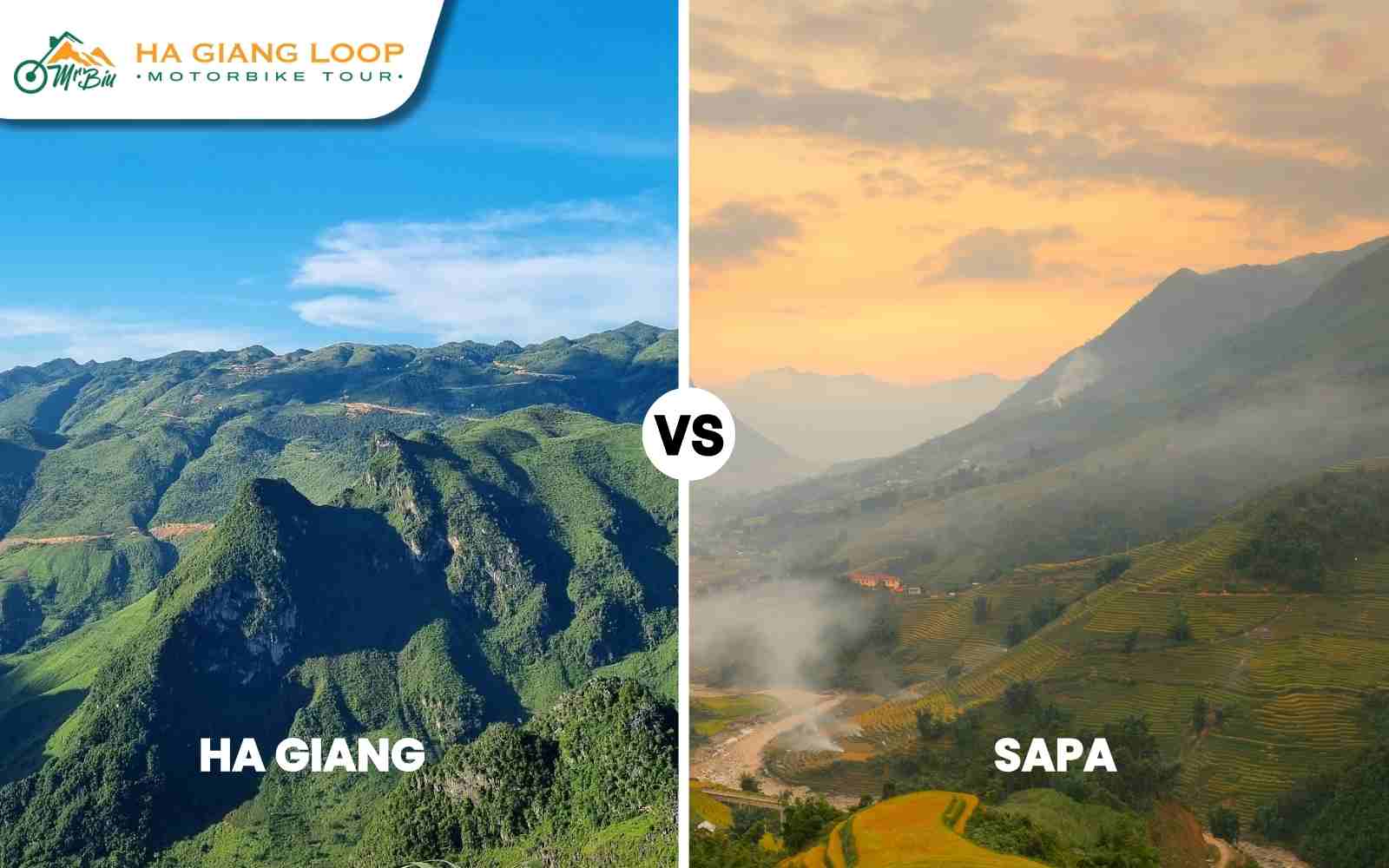
One key factor in deciding between Ha Giang Loop or Sapa is how easy it is to get there. While both destinations are located in northern Vietnam, their accessibility differs significantly. Below are detailed comparisons of Ha Giang Loop vs Sapa.
>> Read more: What to pack for Ha Giang loop: Details Advises
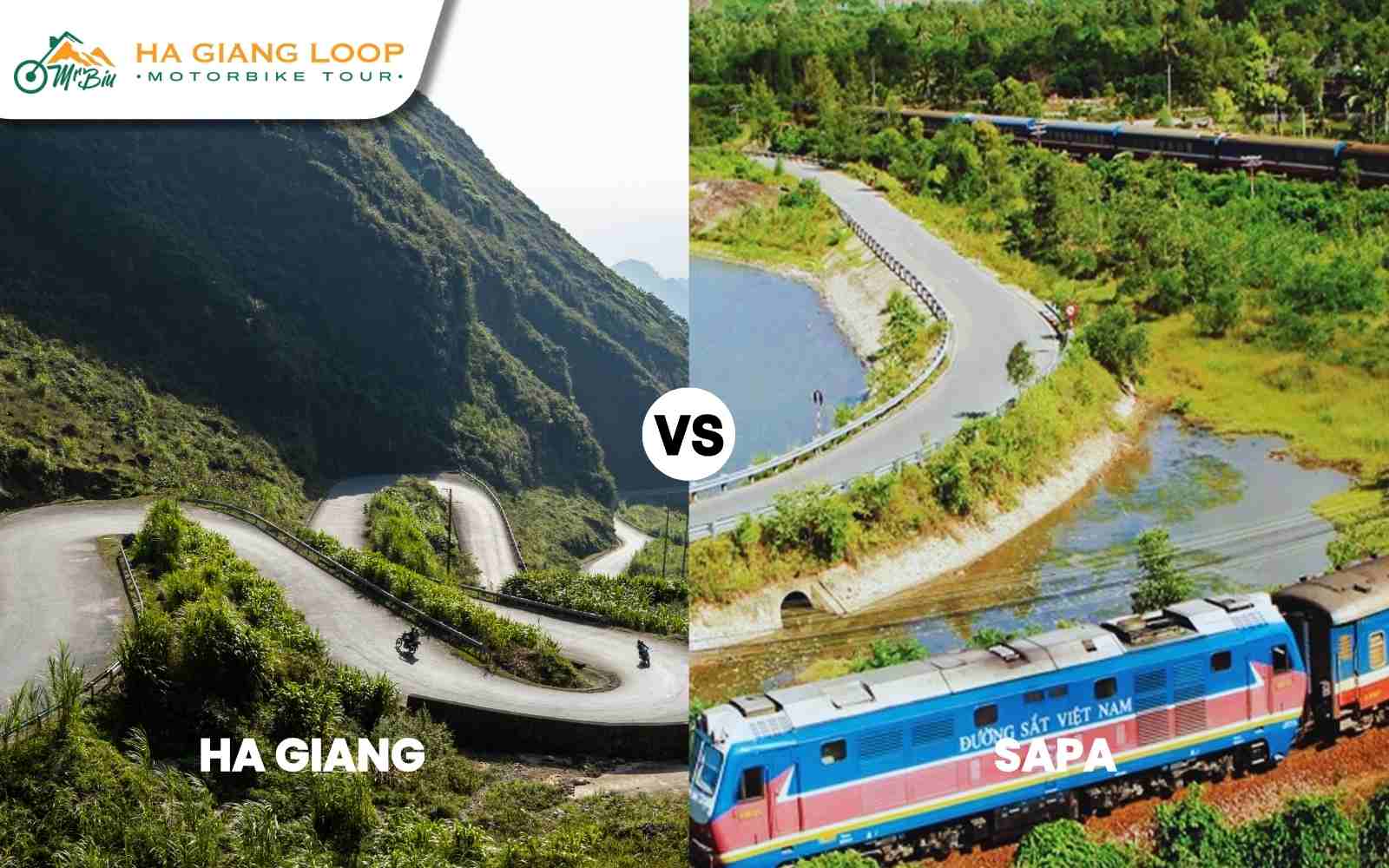
When comparing Sapa vs Ha Giang, Sapa is the more accessible option for most travelers. Located around 320 km from Hanoi and perched at 1,600 meters above sea level in the Hoang Lien Son mountain range, Sapa is well-connected by various transport modes. The most comfortable route is the overnight train from Hanoi to Lao Cai (near the Chinese border), followed by a one-hour road transfer to reach Sapa town. Trains offer multiple cabin classes to suit different budgets and comfort needs. Alternatively, the new highway allows a direct drive from Hanoi to Sapa in just 5.5 to 6 hours by bus or private car. With well-maintained roads and consistent transport services, Sapa is ideal for travelers on tighter schedules or those less inclined toward long, rugged journeys.
Ha Giang is a more remote and adventurous destination, ideal for those seeking off-the-beaten-path experiences. The journey from Hanoi to Ha Giang takes about 7 to 9 hours by sleeper bus or private van. Along the routes on two wheels, you can enjoy the fresh air and winding roads that are worth your adventure, especially as you approach Ha Giang City and beyond. While the trip is longer, the scenery and cultural immersion make it worthwhile. If you decide on Ha Giang Loop vs Sapa and value adventure over convenience, Ha Giang is the clear winner.
When comparing the natural scenery of northern Vietnam, the debate of Ha Giang Loop vs Sapa often arises. Both destinations offer incredible views but differ significantly in landscape and travel experience.
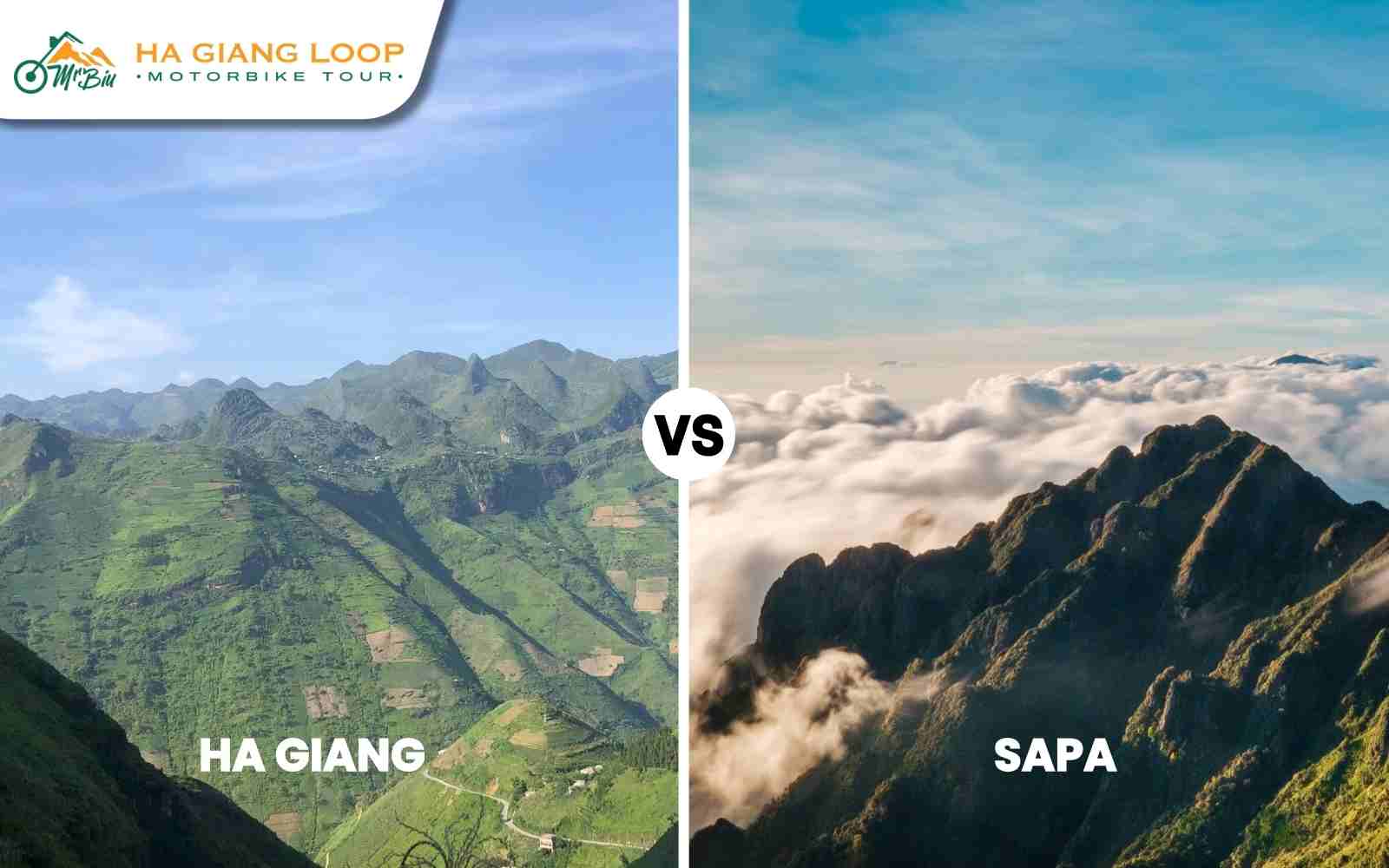
Sapa’s most recognizable feature is its layered rice terraces stretching across the hillsides of Muong Hoa Valley. This valley offers gentle trekking trails through picturesque villages, rice terraces, and ancient rock carvings, perfect for travelers looking for immersive but relaxed nature walks. One of the top attractions is the journey to Fansipan, the highest mountain in Vietnam, accessible via cable car or trekking. Known as the “Roof of Indochina,” it stands tall at 3,143 meters and is Sapa’s crown jewel. This majestic destination allows travelers to explore the stunning landscapes while enjoying the fresh air.
If you’re seeking raw adventure, Ha Giang delivers, especially when you explore the breathtaking mountain passes in Ha Giang. Its dramatic karst topography sets Ha Giang apart—towering limestone peaks, deep valleys, and sharp mountain ridges stretching across the horizon. The most iconic part of the journey is the Dong Van Karst Plateau, a UNESCO Global Geopark that showcases millions of years of geological history. Riding through this region gives you a feeling of entering another world where nature is wild and majestic.
One of the top highlights is the Ma Pi Leng Pass, a winding road carved into cliffs that overlook the emerald-green Nho Que River. Many travelers consider this pass the most beautiful in Vietnam and Southeast Asia. The road offers panoramic views and heart-pounding turns that thrill every adventurer. Whether you’re a solo rider or part of a tour group, the sense of freedom and scale is unforgettable.
If your travel goal is to connect with local culture, the debate between Ha Giang or Sapa which one is better, becomes more interesting. To be more specific:
Ha Giang and Sapa are both rich in ethnic diversity, home to communities like the Hmong, Dao, Tay, and Giay, who live harmoniously with nature. However, Ha Giang stands out for its more traditional atmosphere, with less influence from tourism compared to Sapa. In Sapa, many locals are involved in tourism, often approaching visitors as guides or vendors. While informative, these interactions can sometimes feel overly curated. In Ha Giang, especially during the Loop, you’ll have the chance to stay in family-run homestays and witness local festivals where the traditions are still preserved. The villages in Ha Giang, with their rustic charm and authentic experiences, offer a deeper connection to local culture. So, if you’re wondering which destination offers a more genuine cultural experience, Ha Giang certainly provides more authentic interactions with its vibrant communities and rich traditions.
>>Read more: Top 10+ Ha Giang festivals that should be on your bucket list
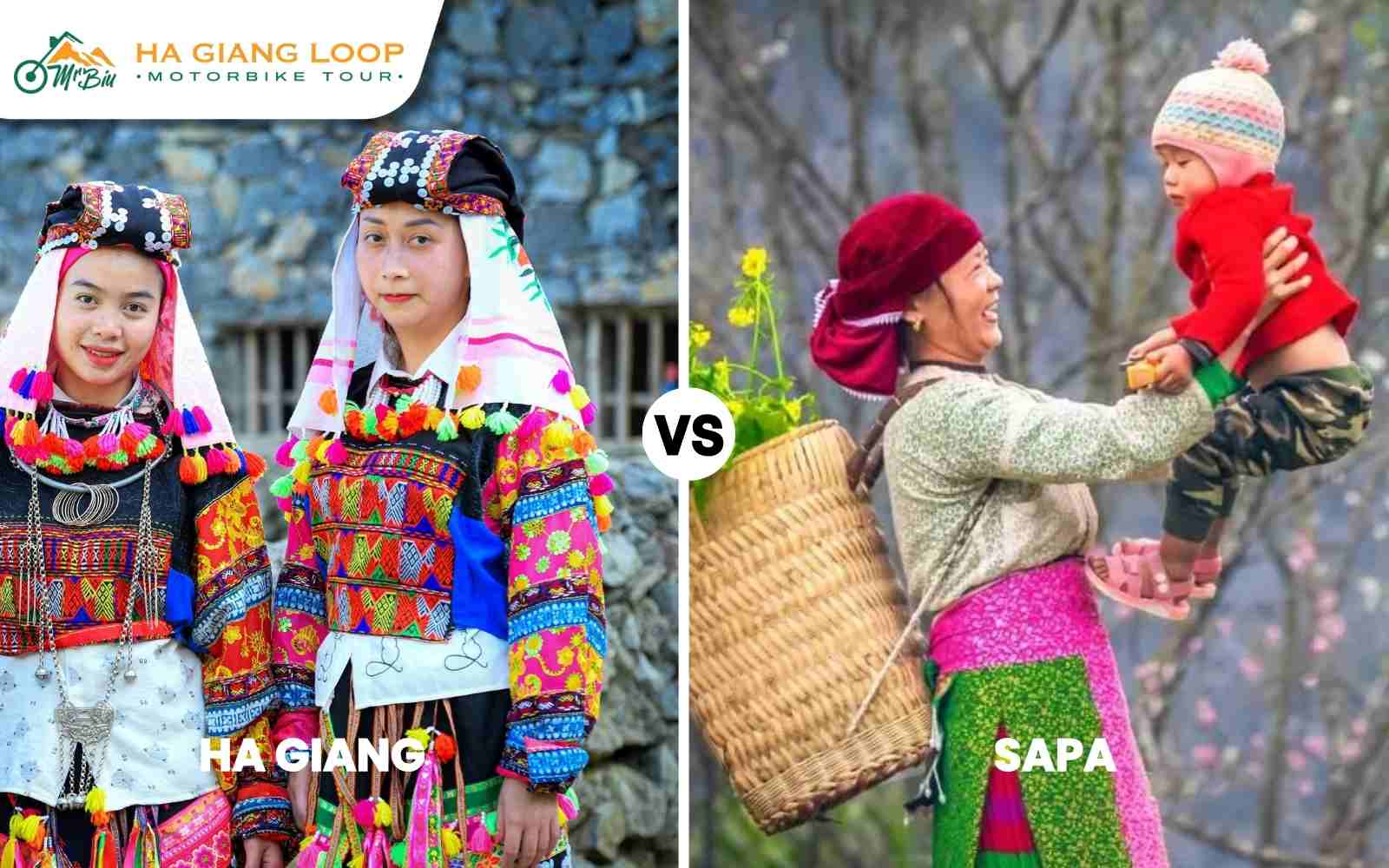
Markets are a great way to experience local life. In Sapa, popular markets like Bac Ha and Coc Ly are colorful but often crowded with tourists. In contrast, Ha Giang’s Dong Van Market and the unique Khau Vai Love Market offer raw cultural experiences where ethnic groups gather to trade, socialize, and celebrate traditions. If you compare Ha Giang and Sapa for authentic market vibes, Ha Giang offers a deeper dive.
>> Read more: Discover the Top 12 traditional Ha Giang markets
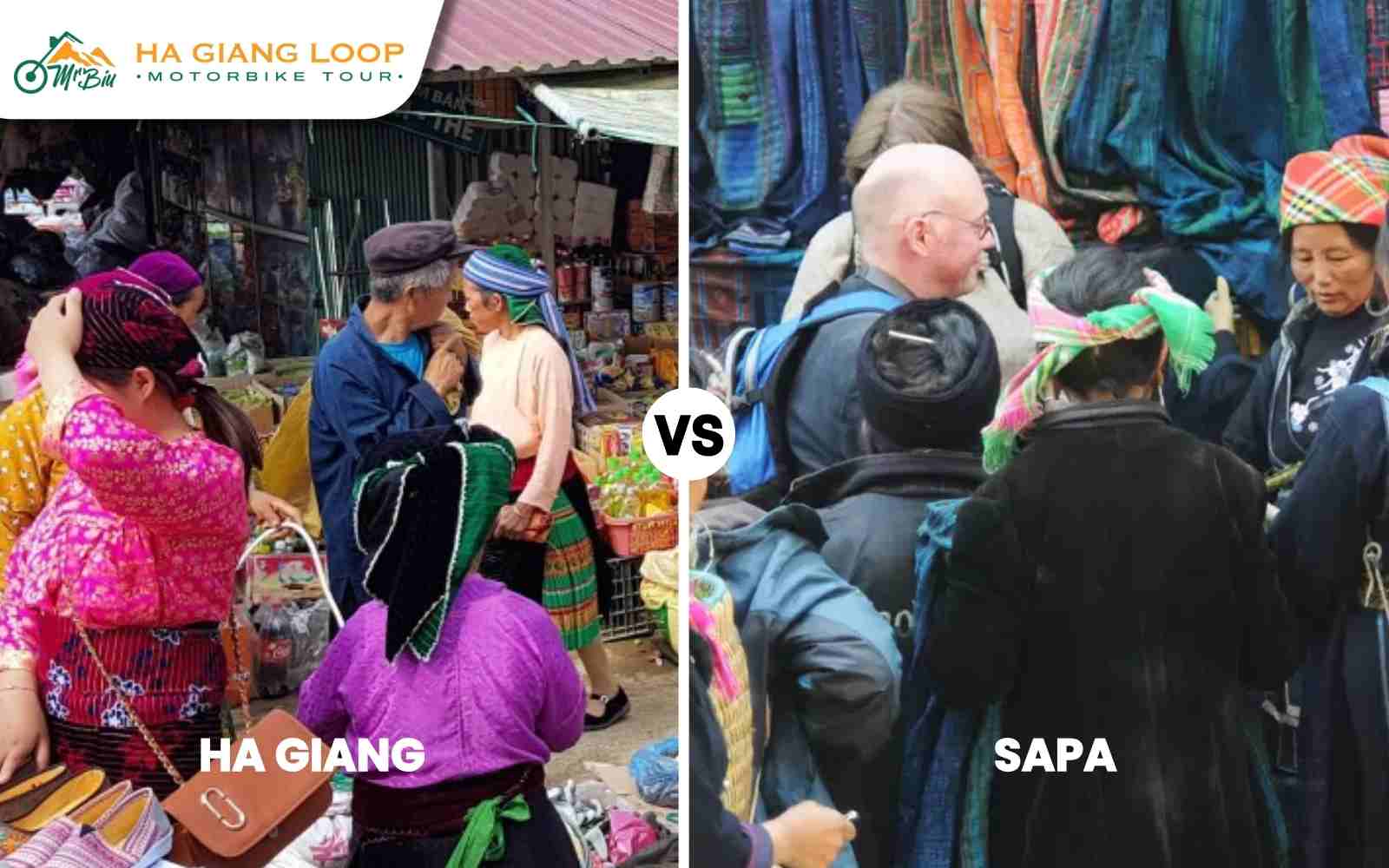
Finding the right place to stay can shape your entire travel experience. While both Ha Giang and Sapa offer overnight options for travelers, the type of accommodation and what you get out of it varies significantly between them. Let’s compare what each destination has in store regarding lodging comfort, atmosphere, and authenticity.
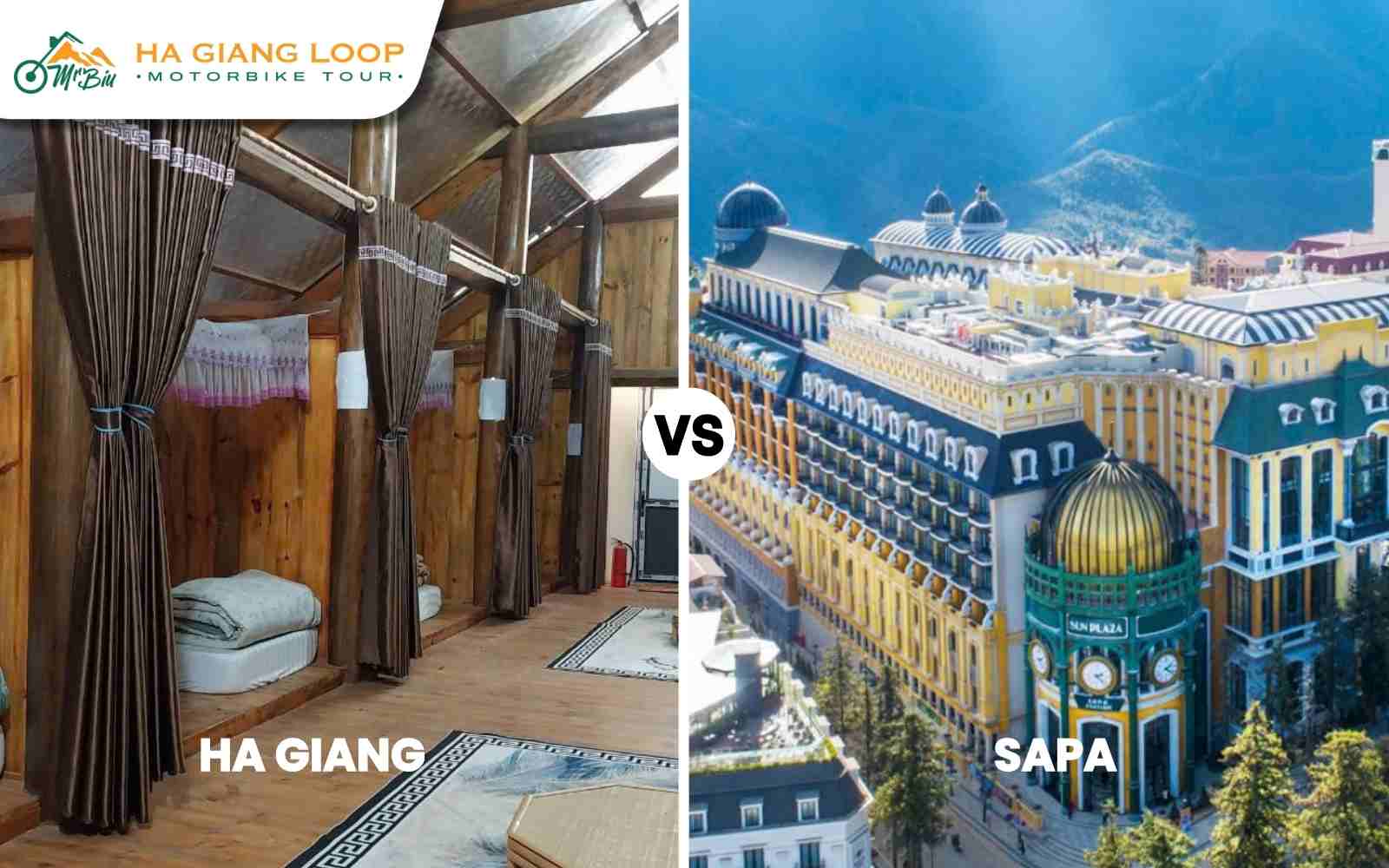
Sapa has a well-developed tourism infrastructure and offers a wide range of accommodations. From luxury hotels with stunning mountain views to boutique stays and budget-friendly homestays, travelers can find something for every preference and budget. Most hotels are located near the town center, making it easy to explore on foot. This variety makes Sapa a good fit for families, couples, or solo travelers looking for comfort.
Accommodation in Ha Giang is generally more straightforward but deeply authentic. Most travelers visiting this region stay in traditional homestays or small family-run hotels along the Ha Giang Loop. While the number of accommodation options is fewer compared to Sapa, the experience of staying in a homestay in Ha Giang is more profound, as visitors can connect with local ethnic communities and enjoy cozy home-cooked meals. You won’t find 5-star resorts here, but you will discover genuine connections and a unique charm.
When comparing the best times to visit Ha Giang and Sapa, it’s important to consider the seasons, as each location offers unique experiences throughout the year.
If you’re planning a winter trip, you might wonder, “Ha Giang vs Sapa in December, which is better?”. In Sapa, December brings misty mornings and cold air, with temperatures ranging from 5 to 10 degrees Celsius, even dropping to 0 degrees, and the possibility of frost or snow on Fansipan. It’s the perfect choice for those seeking winter scenery and immersing themselves in the romantic, misty atmosphere, where visibility can be extremely low. Some of the must-try activities in Sapa in December include conquering Fansipan Peak, exploring Cat Cat Village, admiring the beauty of cherry blossoms, or participating in traditional festivals.
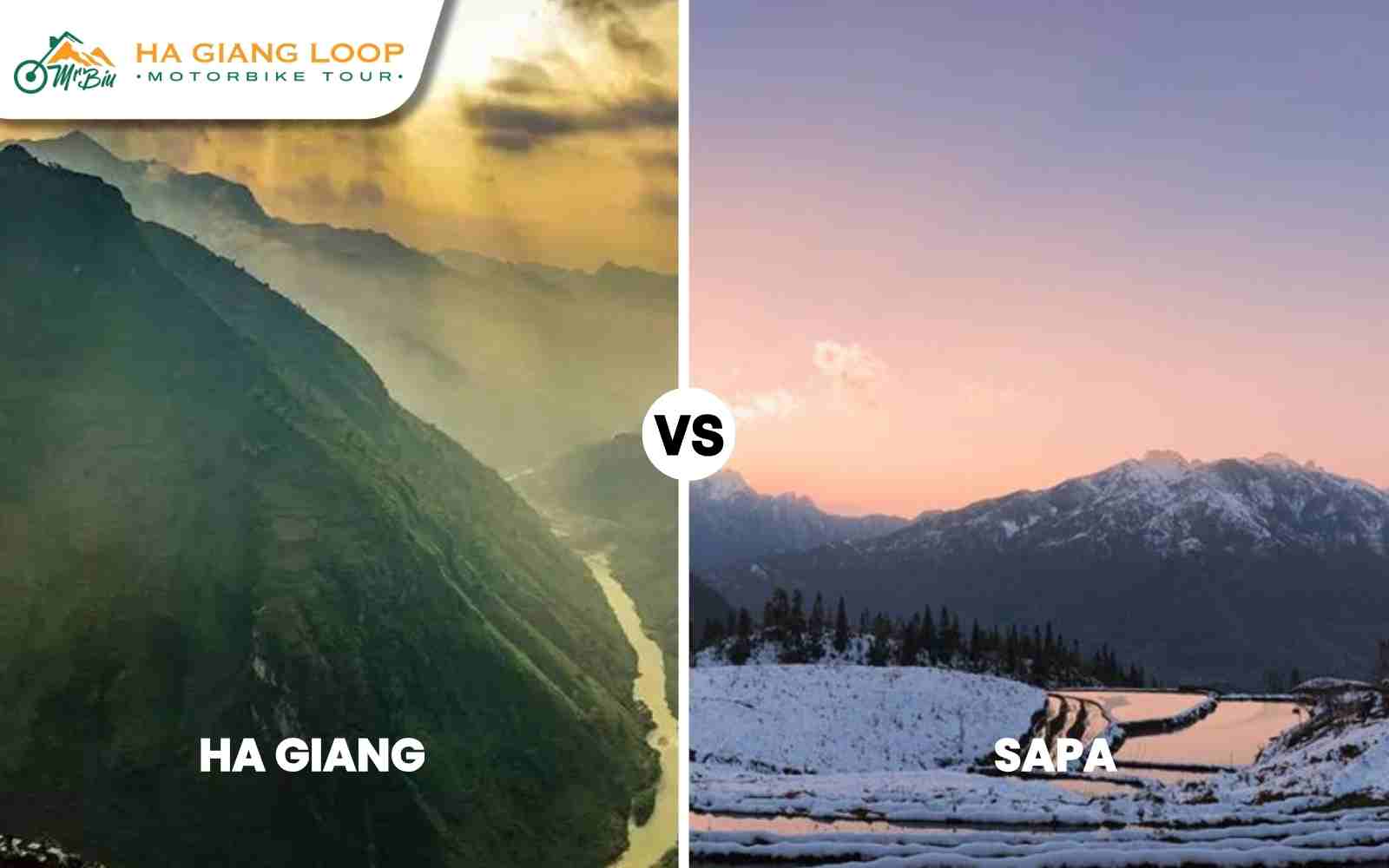
Sapa is best in September and October when the rice terraces glow with golden hues—perfect for photography lovers. Another ideal time is April and May, with mild weather, clear skies, and blooming flowers. These months offer excellent trekking conditions and comfortable temperatures.
Ha Giang, on the other hand, is most beautiful from September to November, especially during the buckwheat flower season and harvest time. The Loop is also great in March to May, with drier weather and vibrant landscapes. Ha Giang’s weather can be unpredictable, but that adds to its wild charm.
>>Read moe: Ha Giang in March: Best Time to Explore Stunning Landscapes
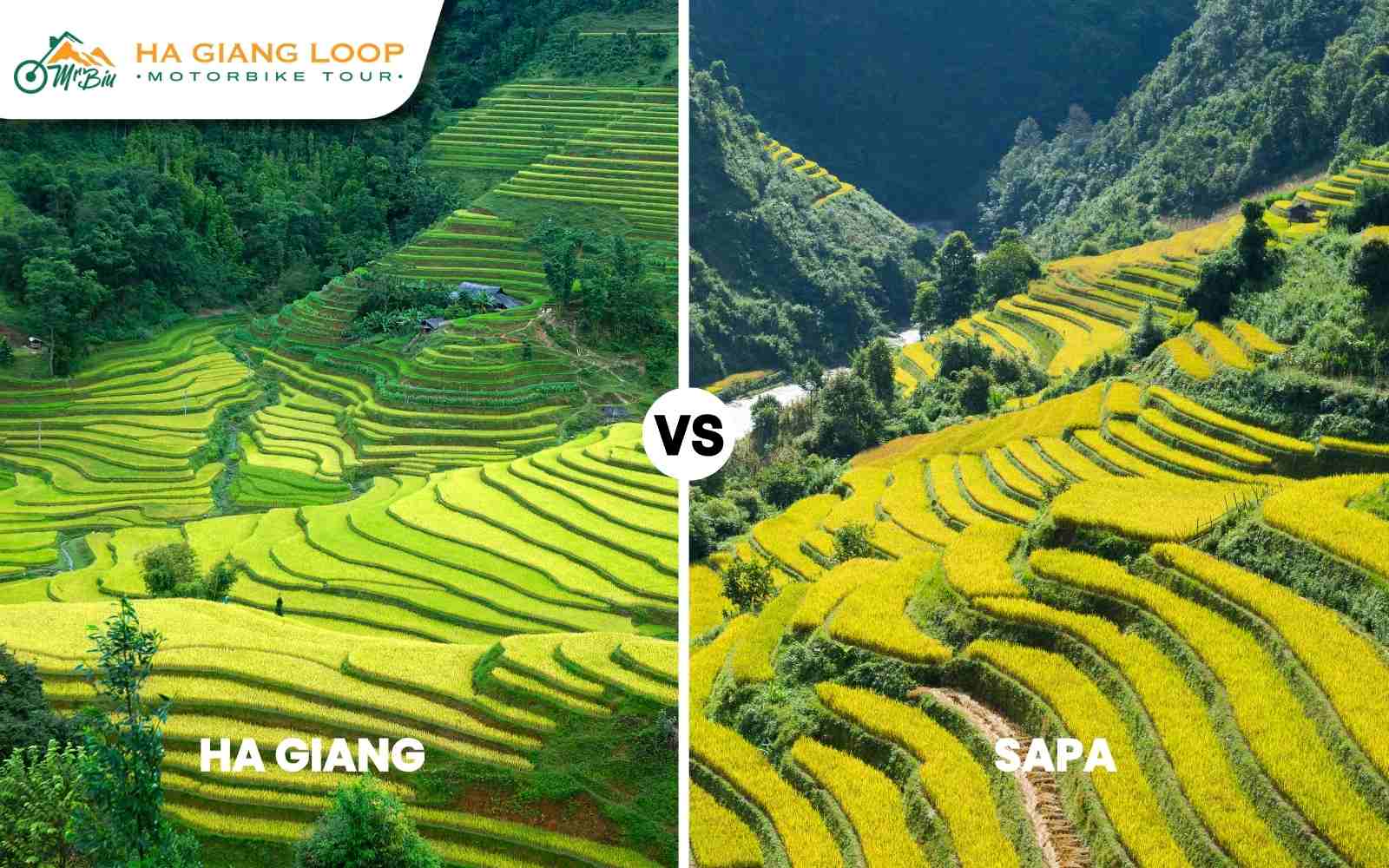
When choosing between Ha Giang Loop and Sapa, your time can decide. Both destinations offer stunning landscapes and cultural depth, but their travel requirements differ significantly.
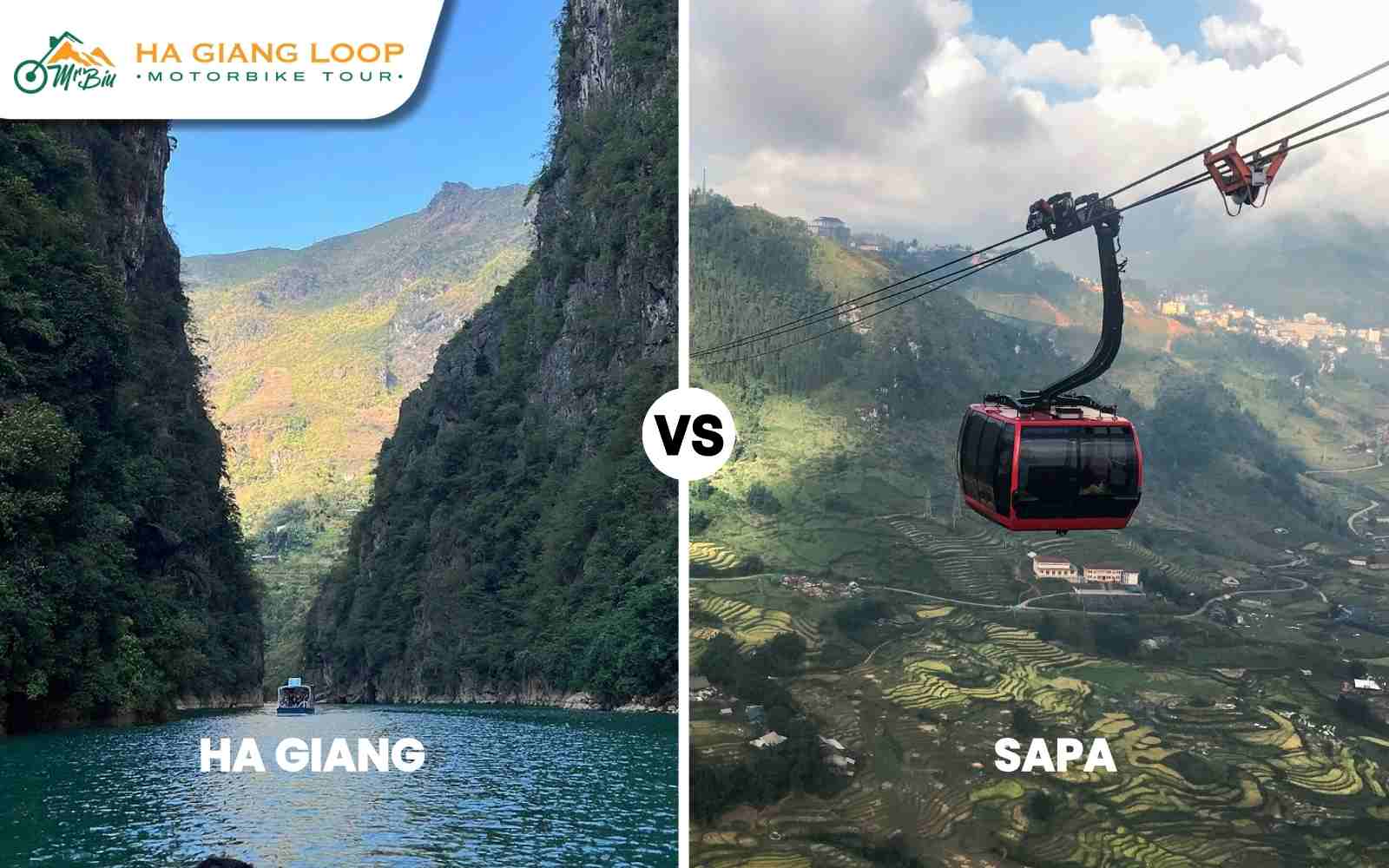
Sapa offers greater accessibility, with travelers only needing about 5 to 6 hours from Hanoi via highway or overnight train. This makes it an excellent option for weekend getaways or those with tight schedules. You can visit attractions like Cat Cat Village and Ham Rong Mountain in just two days or take a cable car to Fansipan Peak.
If you want to travel to Ha Giang, be sure you have enough time and good mental health. The drive from Hanoi takes about 6–8 hours, and the Ha Giang Loop spans hundreds of kilometers of winding mountain roads. To explore the majestic beauty of this place, you need to set aside at least 3 days. However, Mr.Biu Tour Ha Giang recommends spending 4–5 days to discover the magnificent routes like Ma Pi Leng Pass, Dong Van Karst Plateau, Lung Cu Flagpole, and the hidden villages deep in the mountains. For those wondering, “Is Ha Giang better than Sapa?” when it comes to authentic, off-the-beaten-path experiences, the answer is yes—if you can spare the time.
To make your Ha Giang adventure seamless and memorable, Mr.Biu Tour Ha Giang offers two expertly crafted itineraries:
| Ha Giang’s 3 days 2 nights tour | Ha Giang’s 4 days 3 nights tour |
| Perfect for travelers with limited time but a high adventure spirit, the Ha Giang Motorbike Tour 3 Days 2 Nights covers all the highlights of the Ha Giang Loop. Explore Quan Ba Heaven Gate, Dong Van Old Town, Ma Pi Leng Pass, and enjoy a boat ride on the Nho Que River. | The Ha Giang Motorbike Tour 4 Days 3 Nights offers a more relaxed journey with cultural stops, deeper local immersion, and extra time for photography and rest. Explore Dong Van Ancient Market, Tham Ma Pass, Duong Thuong Valley, visit ethnic minority markets, and savor traditional cuisine along the way. |
Book your ideal tour now or leave your contact information for a free itinerary consultation with Mr.Biu Tour Ha Giang. Let’s make your Ha Giang journey unforgettable right today!

Compared to Sapa’s well-trodden trails, Ha Giang offers a sense of untouched wilderness. If you’re wondering, “Is Sapa better than Ha Giang?” or trying to choose between Ha Giang Loop vs Sapa, the answer depends on your travel style.
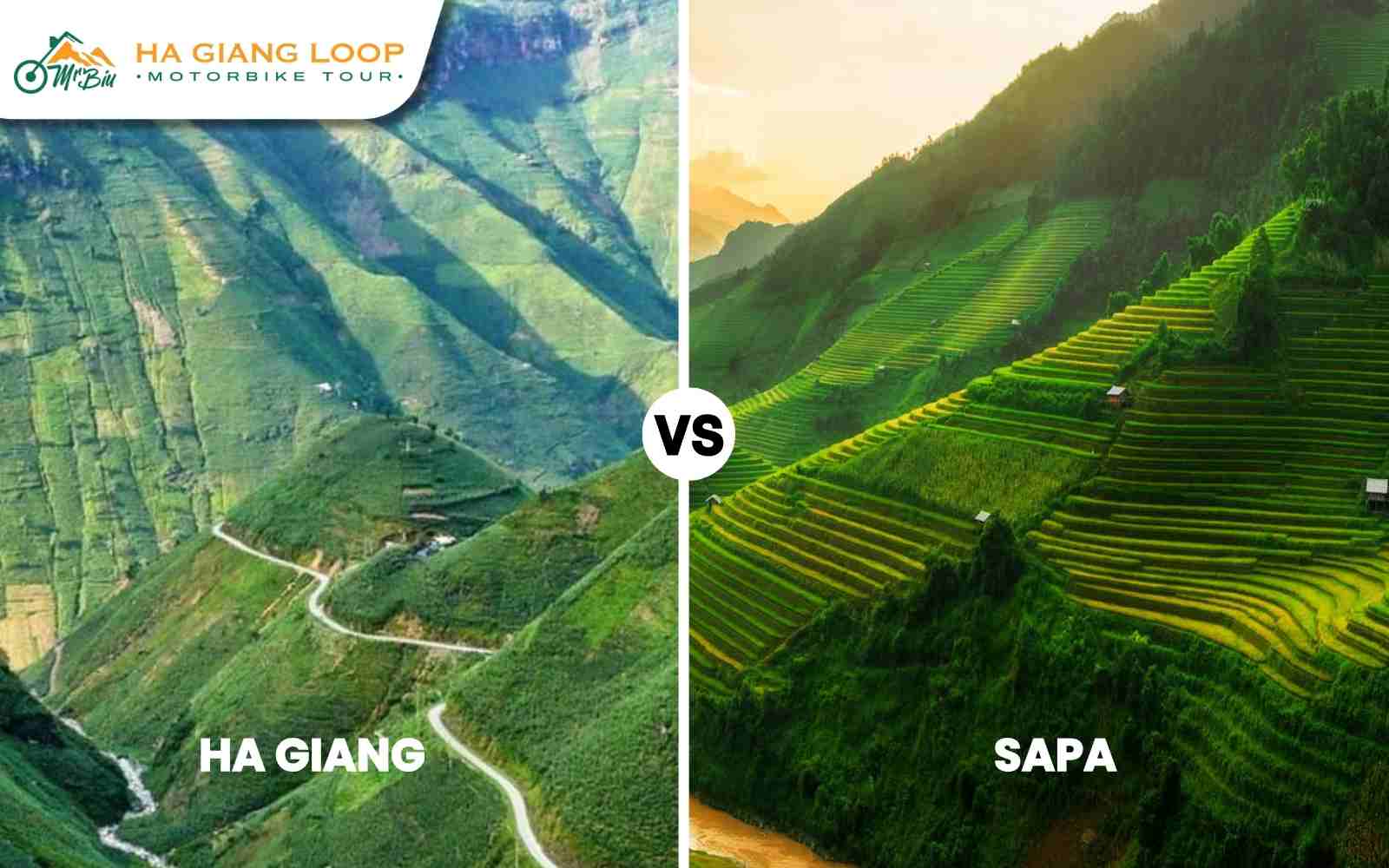
You want a more comfortable, well-rounded travel experience with easy access from Hanoi, various accommodation options, and a broad range of activities. Trekking is one of Sapa’s main draws, primarily through scenic routes like Lao Chai – Ta Van or Muong Hoa Valley. If you dream of standing before the iconic terraced rice fields, especially in September and October, then Sapa is the perfect choice. The town also offers cable car rides to Fansipan Peak, local markets, spas, and diverse dining options.
You can choose Ha Giang if you are drawn to the unspoiled beauty and enjoy exploring less-traveled areas. From the winding roads of Ma Pi Leng Pass to the surreal landscapes of the Dong Van Karst Plateau, this place promises to offer visitors the most spectacular scenery in Vietnam. Additionally, Ha Giang provides an authentic cultural experience, with local homestays and genuine interactions with ethnic minorities such as the H’mong or Tay people.
The choice between visiting Sapa or Ha Giang first depends largely on your overall travel route in northern Vietnam. If your journey continues eastward toward destinations like Ha Long Bay or Cat Ba Island, starting with Sapa makes the most sense. On the other hand, if you intend to return to Hanoi after your mountain adventures, you should begin with Ha Giang and finish in Sapa for a more relaxed ending.
The answer is No. The Ha Giang Loop and Sapa are located in different provinces and not on the same route. The Loop runs entirely within Ha Giang Province, forming a circular route that passes through destinations like Dong Van, Meo Vac, and Ma Pi Leng Pass, close to the Chinese border. In contrast, Sapa belongs to Lao Cai Province, further west, and does not connect directly with the Loop.